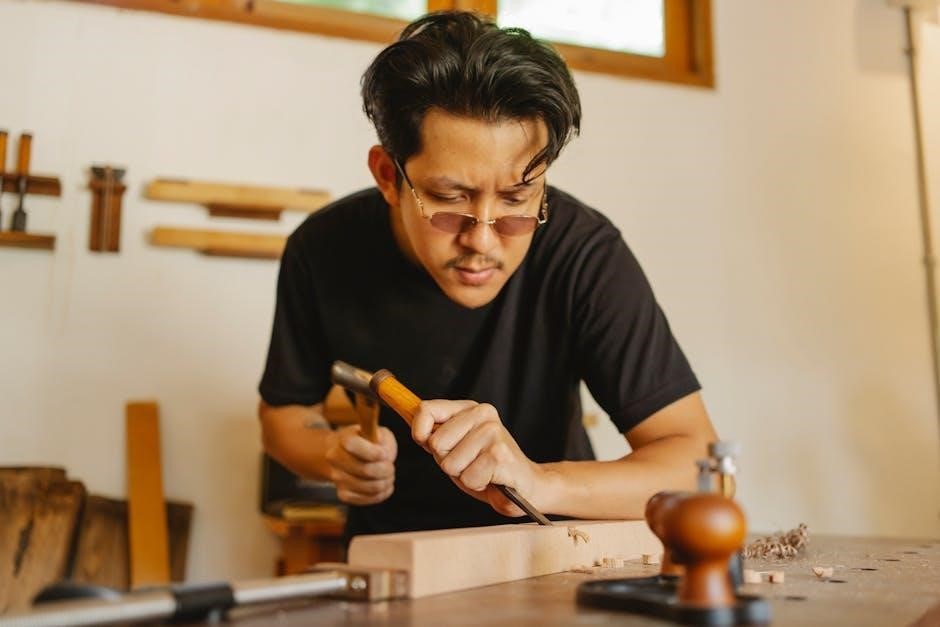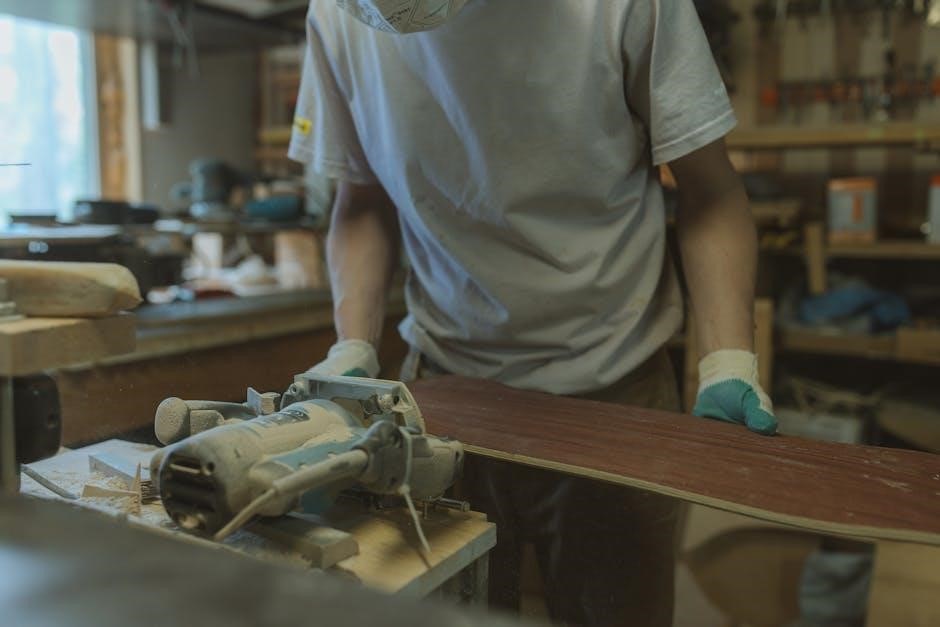
craftsman radial arm saw user manual
The Craftsman Radial Arm Saw is a powerful tool designed for precise cutting and versatility. Its robust motor and adjustable features ensure efficient performance. This manual provides essential setup, alignment, and safety guidelines to maximize productivity and ensure safe operation.
1.1 Overview of the Craftsman Radial Arm Saw
The Craftsman Radial Arm Saw is a versatile and powerful tool designed for precise cutting tasks. It features a robust motor and an adjustable radial arm, allowing for straight, bevel, and miter cuts with ease. The saw is ideal for woodworking, construction, and DIY projects, offering a combination of durability and accuracy. Its design includes a sturdy table surface and a radial arm that can be indexed and locked for consistent results. The saw requires no initial lubrication and is built to handle demanding tasks. With proper setup and maintenance, it ensures reliable performance for years. This manual guides users through setup, operation, and maintenance to unlock its full potential.
1.2 Importance of the User Manual
The user manual is essential for safe and effective operation of the Craftsman Radial Arm Saw. It provides detailed instructions on setup, alignment, and maintenance to ensure optimal performance. The manual outlines safety precautions to prevent accidents and highlights potential hazards. By following the guidelines, users can maximize the tool’s efficiency and extend its lifespan. Proper understanding of the manual’s content is crucial for troubleshooting common issues and performing adjustments. It also serves as a reference for understanding the saw’s features and capabilities. Regularly reviewing the manual helps users stay informed and maintain their saw in peak condition. Adhering to its instructions ensures a safe and productive experience.

Safety Guidelines and Precautions
Always disconnect the power cord before adjusting or servicing the saw. Wear protective gear, including safety glasses and gloves. Ensure proper setup and alignment. Follow all safety rules to minimize risks.
2.1 General Safety Rules for Radial Arm Saws
Always read and follow the owner’s manual carefully to understand the tool’s application and potential hazards. Disconnect the power cord before making adjustments or servicing the saw. Wear safety glasses, gloves, and avoid loose clothing that could get caught. Ensure the work area is clean and well-lit. Never stand on the tool or use it in an unstable environment. Keep children and bystanders away during operation. Avoid overreaching or applying excessive force, which could cause loss of control. Properly align the blade and table before cutting. Follow all safety labels and instructions to minimize risks of injury or damage.
2.2 Specific Safety Features of the Craftsman Radial Arm Saw
The Craftsman Radial Arm Saw is equipped with a blade guard to protect against direct contact with the cutting tool. The saw features an emergency stop switch for quick power cutoff in case of an accident. The radial arm lock ensures stability during operation, preventing unintended movement. Anti-kickback mechanisms are integrated to control material feeding and reduce the risk of accidents. Additionally, the saw includes safety labels highlighting critical precautions and operating guidelines. These features, combined with proper usage, enhance safety and minimize potential hazards. Always ensure these components are functioning correctly before use. Regular maintenance and adherence to safety guidelines are essential for optimal performance and user protection.
2.3 Emergency Procedures
In case of an emergency, immediately disconnect the power cord from the electrical outlet to stop the saw. If the blade is stuck or binding, do not attempt to remove it while the saw is operational. Use the emergency stop switch to halt the motor instantly. Always keep loose clothing and long hair tied back to avoid entanglement. If an accident occurs, turn off the saw and seek medical attention if necessary. Never attempt to remove debris or adjust settings while the saw is running. Keep a first aid kit nearby and ensure proper ventilation in the workspace. Regularly inspect the saw for any malfunctions and address them promptly to prevent accidents. Always follow the manufacturer’s guidelines for emergency situations.
Assembly and Setup Instructions
Follow the manual’s step-by-step guide to unpack and inventory all parts. Assemble the saw carefully, ensuring proper alignment of the blade and table. Lubricate as needed.
3.1 Unpacking and Inventory of Parts
Carefully unpack the Craftsman Radial Arm Saw and all included accessories. Inspect for any visible damage during shipping. Unpack the motor, radial arm, saw table, and rip fence. Check for hardware like bolts, nuts, and washers. Ensure all components, such as the blade guard and miter gauge, are present. Refer to the manual’s packing list to verify all items. Some parts may be preassembled, like the motor and radial arm. Handle the saw table and components with care to avoid damage. Familiarize yourself with each part before proceeding with assembly. Read the safety section beforehand to ensure safe handling. If any parts are missing or damaged, contact customer support immediately. Proper inventory ensures a smooth assembly process.
3.2 Step-by-Step Assembly Process
Begin by attaching the motor and radial arm to the saw table using the provided hardware. Ensure all bolts are securely tightened but avoid overtightening. Next, install the rip fence, aligning it parallel to the blade. Attach the miter gauge to the table, ensuring it slides smoothly. Install the blade guard according to the manual’s instructions. Attach the radial arm, locking it at the 0-degree position. Adjust the bevel angle to 0 degrees for initial setup. Finally, ensure all components are properly secured and aligned. Double-check all connections and alignments before plugging in the saw. Test the radial arm’s movement to ensure smooth operation; Refer to the manual for specific torque values and adjustment procedures. Proper assembly is critical for safe and accurate operation.
3.3 Aligning the Saw Blade and Table
Proper alignment of the saw blade and table is crucial for accurate cuts and safe operation. Begin by ensuring the blade is parallel to the rip fence. Adjust the radial arm to align with the blade’s cutting edge. Use the provided alignment tools to fine-tune the blade’s position relative to the table. Check the bevel angle and ensure it is locked at 0 degrees for straight cuts. Verify that the miter gauge moves smoothly and is square to the blade. If misalignment occurs, refer to the manual for specific adjustment procedures. Proper alignment ensures precise cuts and prevents potential safety hazards during operation. Always double-check alignment before cutting.
3.4 Adjusting the Radial Arm
Adjusting the radial arm ensures precise control over your cuts. Begin by loosening the radial arm locking lever located at the pivot point. Move the arm smoothly through its range of motion to ensure there is no binding or resistance. To set the arm at a specific angle, use the angle adjustment knob and align the pointer with the desired degree marking on the scale. Tighten the locking lever firmly to secure the arm in place. Always ensure the arm is locked before making a cut. If the arm feels loose or unstable, check the pivot bolts and tighten as needed. Proper adjustment ensures accurate cuts and safe operation. Never operate the saw with an unlocked radial arm.

Operating the Craftsman Radial Arm Saw
Operating the Craftsman Radial Arm Saw involves understanding the controls, making precise cuts, and utilizing adjustable features for optimal performance. Always follow safety guidelines and manual instructions.
4.1 Understanding the Controls and Features
Understanding the controls and features of the Craftsman Radial Arm Saw is essential for safe and efficient operation. The saw includes a power switch, blade guard, fence, and miter gauge. The radial arm allows for precise adjustments, enabling bevel and miter cuts. The fence ensures straight cuts, while the miter gauge provides accurate angle settings. Familiarize yourself with the location and function of all controls before use. Regularly inspect the blade guard to ensure proper operation. Refer to the manual for detailed descriptions and diagrams of each feature to maximize functionality and safety. Proper control usage enhances cutting accuracy and prevents potential hazards. Always disconnect power before making adjustments.
4.2 Making Straight Cuts
Making straight cuts with the Craftsman Radial Arm Saw requires proper alignment and setup. Ensure the blade is aligned with the fence and the table is clean of debris. Position the material firmly against the fence and hold it steady. Lower the blade slowly and smoothly, maintaining consistent pressure. Use the rip fence for precise guidance. Always keep your hands away from the blade path. For optimal results, align the blade with the material before starting the cut. Adjust the saw’s depth to match the material thickness. Use a push stick or other safety devices if necessary. Ensure the saw is unplugged before making adjustments. Proper technique ensures accurate and safe straight cuts every time.
4.3 Performing Bevel and Miter Cuts
Performing bevel and miter cuts requires precise adjustment of the saw’s angle settings. For bevel cuts, tilt the blade to the desired angle using the bevel adjustment lever. Ensure the material is securely positioned against the fence. For miter cuts, use the miter gauge to guide the material at the specified angle. Always align the cutting mark with the blade before starting. Apply steady, consistent pressure to maintain accuracy. After completing the cut, allow the blade to stop before raising it. Adjustments may be needed for optimal results. Practice on scrap material to refine your technique. Proper alignment and angle settings are key to achieving clean, precise bevel and miter cuts.
4.4 Using the Rip Fence and Other Accessories
The rip fence is essential for making straight, accurate cuts. Align the fence with the blade, ensuring it is parallel for consistent results. Secure the material firmly against the fence before cutting. For angled cuts, adjust the fence position as needed. Other accessories, such as miter gauges, enhance precision by guiding the material at specific angles. Dust collection systems can be attached to minimize debris and improve visibility. Always install accessories according to the manual to maintain safety and performance. Regularly inspect and clean the fence and accessories to ensure proper function. Proper use of these features will significantly improve the quality and consistency of your cuts.
Maintenance and Upkeep
Regular lubrication, thorough cleaning, and periodic checks are crucial for maintaining optimal performance. Inspect for wear, replace parts as needed, and store the saw properly.
5.1 Lubrication Requirements
Proper lubrication is essential for the smooth operation of your Craftsman Radial Arm Saw. Upon purchase, the saw requires no initial lubrication, as it is pre-lubricated. However, periodic checks are necessary to ensure moving parts remain well-lubricated. Avoid lubricating the area between the radial arm cap and the radial arm, as this can attract dust and debris, potentially causing malfunctions. Use high-quality, lightweight machine oil for lubrication, applying it sparingly to pivot points and moving components. Over-lubrication should be avoided to prevent residue buildup. Always refer to the owner’s manual for specific lubrication points and recommendations. Proper lubrication will extend the life of your saw and maintain its performance.
5.2 Cleaning the Saw and Its Components
Regular cleaning is crucial for maintaining the performance and longevity of your Craftsman Radial Arm Saw. Use a soft cloth or brush to remove dust and debris from the saw table, radial arm, and other components. Avoid using harsh chemicals or abrasive materials that could damage the finish or harm electrical components. For tougher residue, a mild detergent solution can be applied, but ensure all surfaces are dried thoroughly afterward. Pay particular attention to the blade area and miter slots, as buildup can affect accuracy. Disconnect the power cord before cleaning to prevent accidental start-ups. Consistent cleaning habits will help maintain precision and ensure reliable operation of your saw. This routine care is essential for optimal functionality.
5.3 Checking and Replacing Wear Parts
Regularly inspecting and replacing wear parts on your Craftsman Radial Arm Saw is vital for maintaining its performance and accuracy. Check the saw blade for dullness or damage and replace it as needed. Inspect the radial arm bearings for smooth operation and lubricate if necessary. The rip fence and miter gauge should also be examined for alignment and wear. If any components show signs of excessive wear, such as play in the radial arm or uneven cuts, replace them promptly using genuine Craftsman parts. Refer to the manual for specific replacement procedures and ensure all adjustments are made correctly to maintain precise cutting capabilities. Regular maintenance will extend the life of your saw and ensure consistent results. Always prioritize safety during inspections and replacements.
5.4 Storing the Saw Properly
Proper storage of your Craftsman Radial Arm Saw is essential to maintain its condition and ensure longevity. Before storing, clean the saw thoroughly, removing any debris or dust from the table, blade, and radial arm. Apply a light coat of rust-inhibiting oil to unprotected metal surfaces to prevent corrosion. Disconnect the power cord and store it separately to avoid damage. Cover the saw with a durable cover or tarp to protect it from dust and moisture. Store the saw in a dry, cool place, away from direct sunlight and flammable materials. Keep it out of reach of children and unauthorized users. Always follow the manufacturer’s storage recommendations for optimal preservation. Regularly inspect stored components for damage or wear before reuse.
Troubleshooting Common Issues
This section addresses frequent problems with the Craftsman Radial Arm Saw, such as blade misalignment or motor overheating, offering solutions to ensure smooth operation and extend tool life.
6.1 Blade Not Cutting Straight
If the blade of your Craftsman Radial Arm Saw is not cutting straight, it may indicate misalignment or improper installation. Ensure the blade is securely fastened and properly aligned with the table. Check the radial arm for smooth movement and adjust if necessary. Misalignment can also occur due to worn or loose parts. Inspect the fence and rip fence for accuracy and tighten any loose connections. Periodically lubricate moving parts to maintain optimal performance. If issues persist, refer to the alignment instructions in the manual or consider professional adjustment. Regular maintenance and proper setup are crucial for precise cuts.
6.2 Motor Overheating
If the motor of your Craftsman Radial Arm Saw overheats, it may be due to overload or improper setup. Ensure the saw is plugged into a 120-volt, 60 Hz AC power supply, as specified in the manual. Overheating can also occur from prolonged use without adequate breaks or from excessive dust buildup. To resolve this, turn off the saw and allow it to cool. Check for proper alignment of the blade and table, as misalignment can cause unnecessary strain. Regularly clean the motor and surrounding areas to prevent dust accumulation. Lubricate moving parts as recommended to reduce friction. If overheating persists, consult the manual or contact customer support for assistance. Proper maintenance is key to preventing this issue.
6.3 Radial Arm Not Moving Smoothly
If the radial arm of your saw is not moving smoothly, it could be due to improper lubrication or debris buildup. Regularly inspect and clean the radial arm and cap, ensuring they are free from sawdust and dirt. Lubricate the moving parts as specified in the manual to reduce friction and maintain smooth operation. Check for misalignment or loose bolts, as this can disrupt the arm’s movement. Tighten any loose connections and realign the arm if necessary. If the issue persists, refer to the troubleshooting section or contact customer support for further assistance. Proper maintenance ensures optimal performance and longevity of your radial arm saw.
6.4 Other Frequently Encountered Problems
Several issues may arise during the use of your Craftsman radial arm saw. One common problem is the blade not cutting straight, which can be resolved by checking the blade alignment and ensuring it is securely fastened. Motor overheating is another concern, often caused by overloading the saw or inadequate ventilation. Additionally, the rip fence may malfunction if not properly aligned or cleaned regularly. To address these issues, refer to the troubleshooting section of your manual, which provides detailed solutions and maintenance tips. Regular inspection and proper care can prevent many of these problems, ensuring your radial arm saw operates efficiently and safely. Always follow the manufacturer’s guidelines for optimal performance.

Accessories and Optional Equipment
The Craftsman radial arm saw offers a variety of accessories, including interchangeable blades, rip fences, and dust collection systems, enhancing functionality and precision for various tasks.
7.1 Recommended Blades and Accessories
The Craftsman radial arm saw performs best with high-quality, compatible blades and accessories. General-purpose blades are ideal for most cutting tasks, while rip and crosscut blades offer specialized performance. Accessories like rip fences, miter gauges, and dust collection systems enhance accuracy and efficiency. Ensure all components are designed for your specific model to maintain safety and functionality. Always refer to the user manual for compatibility guidelines and recommendations. Properly fitted accessories prevent vibrations and ensure precise cuts. For optimal results, purchase blades and accessories from authorized retailers or the official Craftsman website to guarantee authenticity and performance. Regularly inspect and maintain these components for consistent tool operation.
7.2 Compatible Dust Collection Systems
A dust collection system is essential for maintaining a clean workspace and improving safety while using your Craftsman radial arm saw. Compatible systems like the Tstak and Versastack dust collection kits are designed to integrate seamlessly with your tool. These systems feature universal adapters and flexible hoses, making them suitable for various setups. The Dewalt FlexVolt dust extractor, compatible with Tstak and Versastack, is a highly recommended option for its efficiency and portability. Always ensure the dust collection system you choose is compatible with your saw’s specifications to maintain optimal performance. Regularly check and maintain the system for proper airflow and dust removal efficiency. This enhances tool longevity and workplace safety.
7.3 Upgrading or Customizing Your Saw
Upgrading or customizing your Craftsman radial arm saw can enhance its functionality and adapt it to specific tasks. Consider integrating compatible accessories like the Tstak or Versastack systems for improved organization and efficiency. The Dewalt FlexVolt dust extractor, compatible with these systems, is a valuable addition for dust management. blade upgrades, such as high-quality carbide-tipped blades, can improve cutting precision and durability. Additionally, exploring interchangeable battery systems from Craftsman NexTec tools can offer versatility for cordless operation. Always ensure any modifications align with the manufacturer’s guidelines to maintain safety and performance. Custom storage solutions, like Versastack chests, can also help keep your workspace organized. Prioritize safety and consult the manual before making any significant changes to your saw.

Warranty and Customer Support
Craftsman offers a comprehensive warranty program, ensuring coverage for defects in materials and workmanship. For assistance, contact customer service directly or visit authorized service centers for repairs.
8.1 Understanding the Craftsman Warranty
The Craftsman warranty provides comprehensive coverage for defects in materials and workmanship. Most tools are backed by a limited lifetime warranty, while others may have specific terms. The warranty ensures free repairs or replacements for faulty parts. Registration is often required for validation. For details, refer to the product manual or visit the official Craftsman website. Warranty claims can be submitted through customer service or authorized service centers. Proper maintenance and adherence to usage guidelines are essential to uphold warranty validity. This coverage underscores Craftsman’s commitment to quality and customer satisfaction, offering peace of mind for tool owners. Always review the warranty terms before filing a claim.
8.2 Contacting Customer Service
For assistance with your Craftsman radial arm saw, contact customer service via phone, email, or through the official website. Representatives are available to address questions, repairs, or warranty claims. Visit the Craftsman website for contact details and support resources. When reaching out, have your tool’s model number and serial number ready for efficient service. Additionally, authorized service centers can be located using the dealer locator tool on the website. Craftsman customer service aims to provide timely and effective solutions, ensuring your tool operates at peak performance. For further support, explore the FAQ section or download the user manual directly from the website.
8.3 Finding Authorized Service Centers
Locating an authorized service center for your Craftsman radial arm saw is straightforward. Visit the official Craftsman website and use the dealer locator tool. Enter your location details to find nearby centers. These centers are equipped to handle repairs, maintenance, and warranty claims. Ensure your saw is serviced by professionals to maintain its performance and warranty validity. Contact customer service for additional assistance in finding the nearest center. Regular maintenance at authorized centers ensures optimal functionality and extends the tool’s lifespan. Use genuine parts and follow guidelines for reliable service.

Additional Resources
Explore online forums and communities for tips and troubleshooting. Watch video tutorials for operational guidance. Visit the Craftsman website for downloadable manuals and support.
9.1 Downloading the User Manual
The Craftsman radial arm saw user manual is readily available for download as a PDF file. Visit the official Craftsman website or authorized retailers like Lowe’s. Ensure you have Adobe Acrobat Reader installed to view the document. The manual covers essential topics such as assembly, safety guidelines, and troubleshooting. For specific models like the 113.199250, the manual includes detailed diagrams and part lists. Downloading the manual ensures you have access to critical information for optimal performance and maintenance. Always refer to the official sources to avoid outdated or incorrect versions. This resource is indispensable for both novice and experienced users.
9.2 Online Forums and Communities
Online forums and communities are invaluable resources for Craftsman radial arm saw users. Platforms like forums and social media groups offer a space to share experiences, ask questions, and gain insights from experienced users. Many enthusiasts discuss troubleshooting tips, maintenance advice, and modifications. Additionally, these communities provide reviews of accessories and compatible tools. Active participation can help users optimize their saw’s performance and address common issues. For example, discussions about blade compatibility and maintenance routines are frequent topics. Engaging with these communities enhances your understanding and ensures you get the most out of your tool. They are a complement to the official user manual, offering real-world advice and support.
9.3 Video Tutorials and Guides
Video tutorials and guides provide visual instruction for mastering the Craftsman radial arm saw. These resources cover topics like assembly, blade alignment, and maintenance. Official channels and third-party creators on platforms like YouTube offer step-by-step demonstrations. Videos often include tips for making precise cuts, adjusting the radial arm, and troubleshooting common issues. Many tutorials also focus on safety practices and optimal tool usage. They are particularly helpful for beginners or those unfamiliar with radial arm saws. Additionally, video guides can clarify complex procedures outlined in the user manual. By watching these tutorials, users can gain confidence and improve their woodworking skills. They serve as a valuable complement to the written manual, offering hands-on learning opportunities.